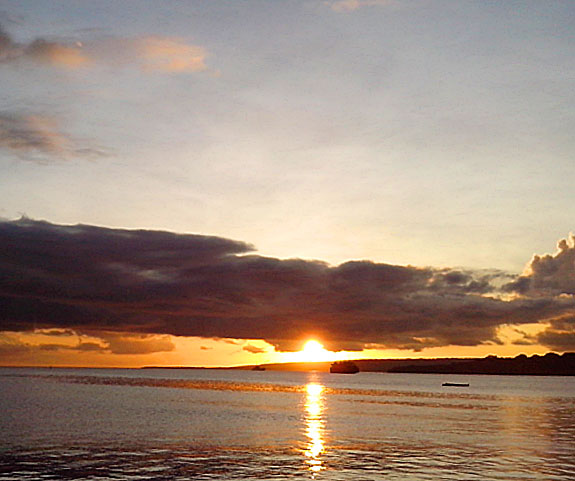Vanuatu National Archives
Vanuatu National Archives Project April 2014
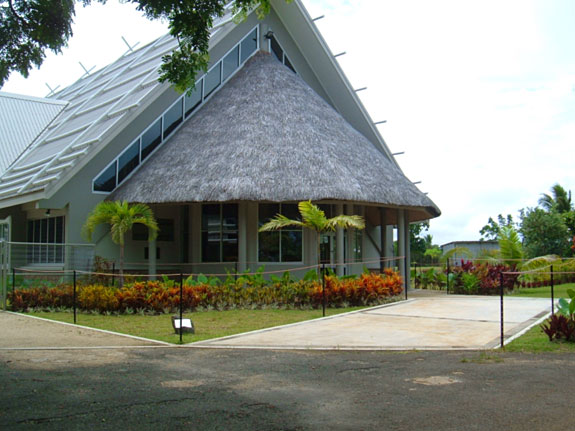
I arrived in Port Vila on April 1st and headed straight to the motel that was conveniently located right next door to the Archives. Although the idea of resting after a long trip from Los Angeles seemed ideal, I was too excited to see the new archives building which opened in August 2013, and rushed over to the archives for a tour. It is a two-story building with the Archives on the first floor, and the Library on the second floor. As one enters the building, he is immediately introduced to a gallery that will also be used as an exhibit area. There are two repositories one on each floor with ample room for the archives collections and books respectively. Overall, perhaps most significantly, this truly magnificent building will stand as a model for other Pacific Islands nations who are interested in creating a new archives building.
The next day is when we eagerly started our project that we titled: The Accessioning and Preserving Colonial Records at the Vanuatu National Archives Project. Together with two archives staff, the goal of this project was to:- train the Archivist Assistant and Library Assistant on preservation procedures and practices;
- assist in cleaning and conserving historic records; and
- aid the National Archivist in accessioning and arranging records.
One of the most significant aims of the project was to give preservation training to the Archivist and Library Assistant. As the collections of the Vanuatu National Archives are mainly composed of paper records at this time, learning the basics of paper preservation was crucial and essential. After the project, the Archivist and Library Assistant will be able to identify the various states of deterioration, and in turn, will be able to apply this new knowledge towards other records and collections in the archives. This is crucial, especially in this harsh environment. Without preserving these historic records, access and use will have to be limited, or restricted due to the fear of losing the records forever.
Although historic records at the Vanuatu National Archives are considered ones that were created before independence in 1980, we decided to concentrate our focus and preservation training on historic Land Records. This collection is one of the most important, and currently, is one of the most accessed in the archives. Land issues are a contentious topic in Vanuatu that is home to 113 distinct cultures and languages, as well as to three official languages of Bislama, French, and English. This diversity can make land ownership complex and ripe for manipulation by governments and foreign powers. For Ni-Vanuatu, the control of land means to control their lives. When they lose the land, they become commodities selling their labour and their culture to survive. Thus, the information that this collection contains is highly needed, as disputes often arise. In fact, there is a terrific saying throughout the country, Graon Hemi Laef, or Land is Life.
The Land Records is a collection that consists of approximately 230 boxes. The documents are mostly written in English and French. The oldest document, an agreement for the sale of a piece of land to the Presbyterian Church on the island of Aneityum, dates to 1852. However, most of the documents we worked with were dated from the late 19th century to the mid-20th century, and were land deed of sales of the Catholic Church on islands such as Anietyum, Malakula, Pentecost- to name a few.
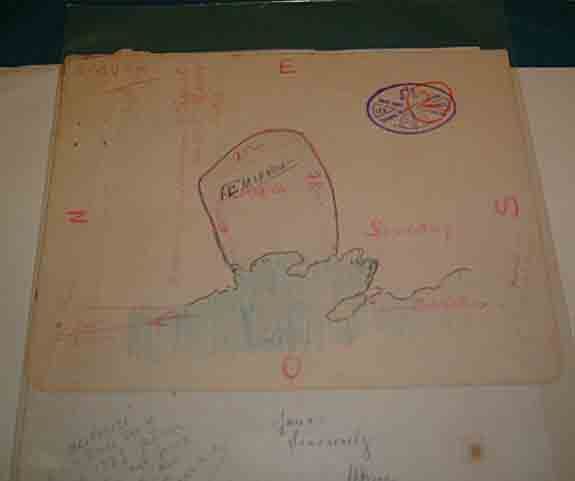
Although the boxes were already listed, the time had come to perform some conservation work with the documents, especially since this collection is heavily used. Our motto was, Yu no rush, as these documents were very brittle and frail. The assistants learned how to clean the documents and remove a plethora of metal fasteners. This took a little coordination and patience, as the slightest slip can easily tear the document. Certain techniques were shown on how to remove the metal fasteners that would help minimize any accidental tears. Also, during this time, we replaced torn and dirty folders clean, acid-free ones. Some documents were straightened and unfolded. Special items such as hand-drawn maps and hand-written letters were placed in polyester folders to protect them when they are being handled by users. Additionally, we repaired small tears in documents and folders that needed to be kept using Japanese paper.
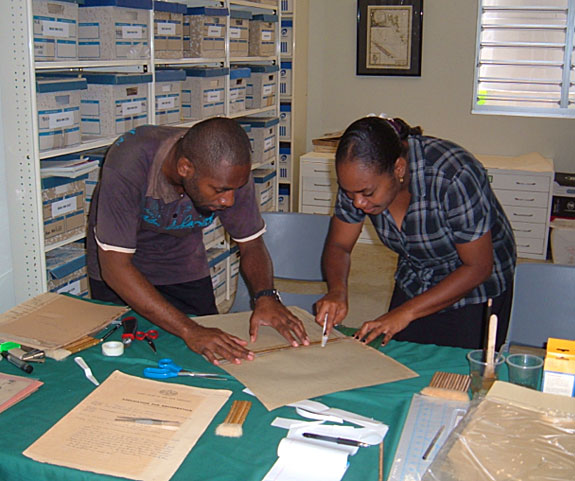
Since the Vanuatu National Archives is mostly composed of paper records, we conducted other small training sessions to improve the longevity this type of records. By using the Pacific Islands Preservation Manual (A small publication that was written for a past FIDA Award in the Solomon Islands) we were able to train on several archival areas. The first topic we discussed was Climate Control. This included looking at the different agents of deterioration and preventative preservation. Having a new building certainly helps, but it was still helpful to look at the ways paper records can be easily affected by different elements.
Another topic that was linked to climate control and was in need of discussion was the handling of pest infestations. Being in a new building was a great start and certainly had the feeling of being pest free. However, it does not take much invitation for pests to make a home in an archives. Thus, we looked at areas such as the kitchen, bathrooms, and storage areas that would need periodic monitoring. We also discussed how periodic housekeeping should be an essential part of the routine. Perhaps, most importantly, we talked about the monitoring of incoming collections. At the moment there is a good system where incoming records are first deposited to the containers before being brought into the archives for processing. The key here is sticking to this policy and making sure that ministries and donors do not drop anything off inside the archives.
Two other areas that we took the time to examine and included in our training process was archival storage practices and handling mold outbreaks. Proper record storage supplies were not only used as examples, but they were used during the course of the project. The main types of archival storage supplies that were used were acid-free folders, polyester folders and record centre boxes. We also discussed about the best practices to store oversize material. Mold outbreaks can easily happen at the archives. Although the best method to control an outbreak of molld is to control the surroundings so that conditions are not suitable for growth, it is not always easy to control mould in Pacific Islands' institutions where high humidity is a daily environmental issue. We examined a mold policy that will combat any outbreaks. This policy was left with the archives so that they can update it to fit their own archival needs.
The Vanuatu National Archives also possess a collection of approximately 250-300 maps. Many of these are considered historic, and are quite heavily used. In fact, the archives would like to digitize this collection as soon as they are ready for such a project. However, for the time being, they are in need of accessioning and preserving. Naturally, the maps are in all shapes and sizes, and consist of six main areas. These include: Specific Provinces of Vanuatu, Port Vila, Luganville, Vanuatu, Building Plans for Port Vila and Luganville, and a Miscellaneous group (such as other Pacific Islands maps). Although some will need a little cleaning and minor repairs, overall, they are in good condition.
Fortunately, the archives did acquire a set of cases to house their maps. The cases will definitely be sufficient for small to medium size maps. However, we needed to think of a way of storing larger or oversize maps that would not harm their integrity. Storing them flat would be ideal, but not possible at this time, as they would take up too much space. Plus, they would be exposed to light and other possible, damaging contaminants. Thus, we decided to keep them rolled, and will look into feasible storage options.
Another issue regarding the maps is that the archives has not taken intellectual control of the collection and thus needed processing. Knowing that we would not be able to process all the maps during the project, we thought it best if we devised a simple processing plan so that staff can chip away at it throughout the rest of the year, or when time presents. The plan consists of four simple steps that help staff process the map item from listing to filing.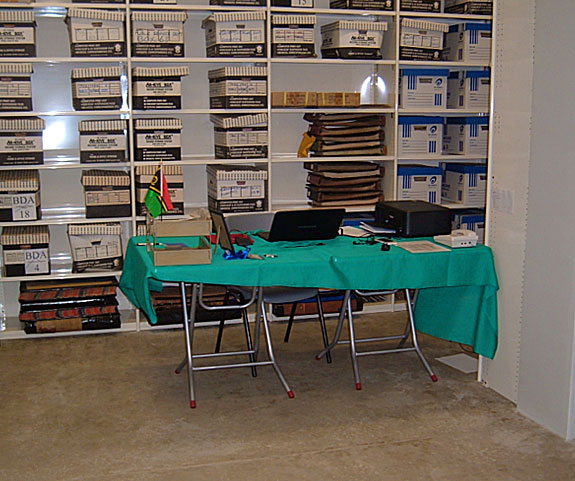
On Tuesday, April 15, the town of Port Vila had closed offices and schools so that people can vote for a new parliament member. Since the Archives was closed for the day, Anne Naupa (Chief Archivist) and I decided to take advantage of this quiet, down time to meet and discuss seven topics, or recommendations that can benefit the archives in the near future. These topics included:
- Adding two trainee Records Management Officers
- Creating a daily work schedule for the Assistant Archivist
- Re-arranging the main storage office for the Assistant Archivist
- Writing a maps processing procedure
- Establishing a Website for the National Archives and National Library
- Finalizing and Acting upon a Disaster Management Plan
- Displaying procedures for clients for access/copy of records.
We were able to accomplish three of these recommendations during the project such as created a daily work schedule for the Archivist Assistant, Re-arranged the main storage office so that at the Archivist Assistant can work more efficiently, and as stated before, established a maps processing procedure.
Overall, the project went very well. The trainees were engaged, and very enthusiastic about the development of new preservation skills. As it was a hands-on training project, we believe we came across many different types of conservation scenarios during the three weeks. Plus, it was another step to allow better access to the records. Finally, the Archives has future plans to digitize certain collections, and we truly felt that this project was needed so that one day their digitization ideas will come to fruition. With such a small staff, it may take some time preserve all the historic boxes in the repository. Nevertheless, the foundation is there to apply their knowledge to other records, as well as to train subsequent staff members, or volunteers.
